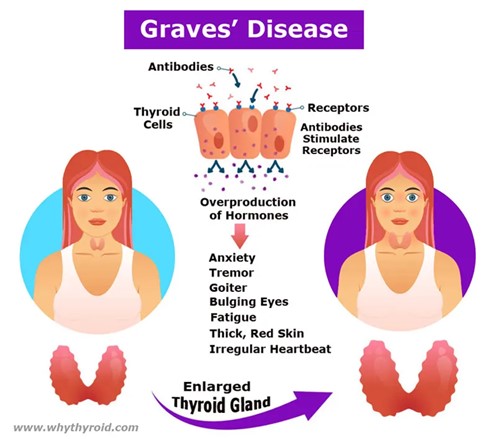A nurse is assessing an adolescent who has an exacerbation of Graves' disease (Hyperthyroidism). Which of the following findings should the nurse expect?
Heat intolerance
Weight gain
Bradycardia
Lethargy
The Correct Answer is A
A) Heat intolerance.
Explanation: This statement is true. Heat intolerance is a common symptom of hyperthyroidism, including Graves' disease. People with hyperthyroidism often have an overactive thyroid gland that produces an excessive amount of thyroid hormones. This can lead to an increased metabolic rate, which in turn makes them sensitive to heat. They may feel excessively warm, sweat more than usual, and have difficulty tolerating hot weather.
B) Weight gain.
Explanation: This statement is false. Weight gain is not a typical finding in Graves' disease or hyperthyroidism. In fact, one of the hallmark symptoms of hyperthyroidism is unexplained weight loss despite increased appetite. The elevated levels of thyroid hormones cause an increase in metabolism, leading to weight loss.
C) Bradycardia.
Explanation: This statement is false. Bradycardia refers to an abnormally slow heart rate, typically below 60 beats per minute. In hyperthyroidism, the heart rate is often elevated rather than slowed down. The excessive thyroid hormones can lead to an increased heart rate (tachycardia) and palpitations. It's important to note that if the question were about hypothyroidism (underactive thyroid), bradycardia might be more relevant.
D) Lethargy.
Explanation: This statement is false. Lethargy, or a state of extreme tiredness and lack of energy, is more commonly associated with hypothyroidism (underactive thyroid) rather than hyperthyroidism. Hyperthyroidism usually leads to symptoms of increased energy, restlessness, and hyperactivity due to the elevated metabolic rate caused by excess thyroid hormones.

Nursing Test Bank
Naxlex Comprehensive Predictor Exams
Related Questions
Correct Answer is ["5.625"]
Explanation
To calculate the dose of amoxicillin for the toddler:
Step 1: Convert the toddler's weight from pounds to kilograms.
33 lb ÷ 2.2 (lb to kg conversion factor) = approximately 15 kg
Step 2: Calculate the total daily dose of amoxicillin.
Dose = 30 mg/kg/day × 15 kg = 450 mg/day
Step 3: Divide the total daily dose into equal doses every 12 hours.
450 mg/day ÷ 2 doses = 225 mg/dose
Step 4: Calculate the amount of amoxicillin suspension needed for each dose.
The available concentration is 200 mg/5 mL, so for 225 mg, you would use the proportion:
225 mg : 200 mg = x mL : 5 mL
Cross-multiplying: x = (225 mg × 5 mL) / 200 mg ≈ 5.625 mL
Therefore, the nurse should administer approximately 5.625 mL of amoxicillin suspension for each dose.
Correct Answer is D
Explanation
A) "I can store unopened bottles of insulin in the freezer."
This statement is incorrect. Insulin should not be stored in the freezer. Insulin should be stored in the refrigerator, and the currently used vial can be kept at room temperature for up to 28 days to avoid the discomfort of injecting cold insulin.
B) "I should not take my regular insulin when I am sick."
This statement is incorrect. When a person with type 1 diabetes is sick, it's important to continue taking insulin. In fact, during illness, blood sugar levels can become more difficult to manage, and insulin may be needed in adjusted doses. Skipping insulin during sickness can lead to uncontrolled blood sugar levels and potentially worsen the illness.
C) "My morning blood glucose should be between 90 and 130."
This statement is a good range to aim for in terms of fasting blood glucose levels, but it's not an indication of understanding the teaching about diabetes management as a whole. While this knowledge is important, the statement about eating a snack before playing soccer directly reflects understanding of how to manage blood sugar during physical activity.
"D) I should eat a snack half an hour before playing soccer."
Explanation:
Managing blood sugar levels is crucial for individuals with type 1 diabetes, especially when engaging in physical activities like playing soccer. Eating a snack before playing helps prevent hypoglycemia (low blood sugar) during exercise. Physical activity can cause the body to use up glucose faster, potentially leading to low blood sugar levels, and having a snack before exercise can help maintain stable blood sugar levels.
Whether you are a student looking to ace your exams or a practicing nurse seeking to enhance your expertise , our nursing education contents will empower you with the confidence and competence to make a difference in the lives of patients and become a respected leader in the healthcare field.
Visit Naxlex, invest in your future and unlock endless possibilities with our unparalleled nursing education contents today
Report Wrong Answer on the Current Question
Do you disagree with the answer? If yes, what is your expected answer? Explain.
Kindly be descriptive with the issue you are facing.
